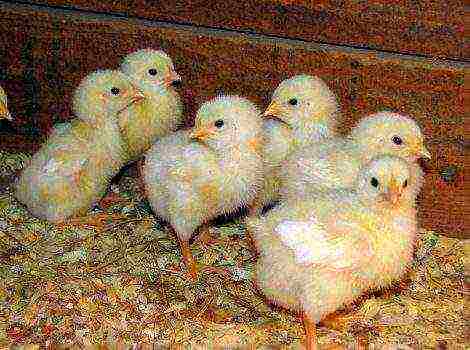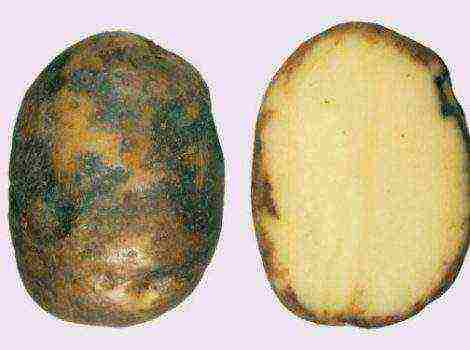Content
- 1 Chickens Master Gray - description and characteristics of the breed
- 1.1 Meet the chicken master gray
- 1.2 What does this breed look like - photo and description
- 1.3 Keeping chickens
- 1.4 Positive characteristics of the cross
- 1.5 From chicken to layer
- 1.6 Feed for chickens and adult poultry
- 1.7 Diseases of chickens, treatment
- 1.8 Analogs of meat and egg crosses
- 1.9 Reviews from forums and videos about the breed
Chickens Master Gray - description and characteristics of the breed
By the nature of the products obtained, there are meat, egg, and meat-and-meat chicken lines.
Poultry farmers of private farms prefer meat breeds of chickens because they are extremely profitable.
Meet the chicken master gray
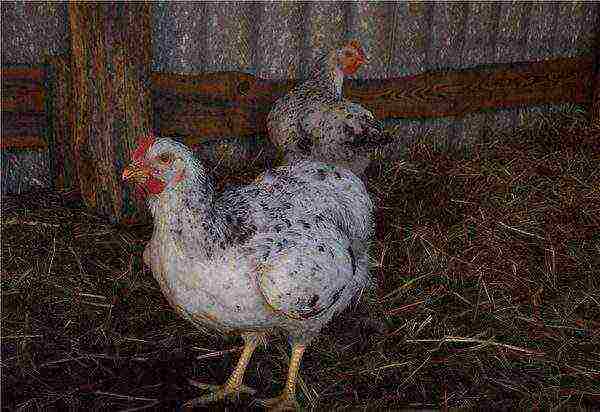 Modern farmers are deeply interested in the Master Gray cross, another name for the Master Gris.
Modern farmers are deeply interested in the Master Gray cross, another name for the Master Gris.
Master gray chickens were obtained by the French breeders of the Hubbard company for the backyard economy. There are varieties bred by the specialists of the same company: Master Gray M and Master Gray S.
What does this breed look like - photo and description
A large white-gray bird with a bright red beard and scallop, larger than other crosses. It is distinguished by its high growth, long body, broad back, strong, medium-length legs.
 Gray feathers are interspersed with white throughout the plumage. Gray color predominates over white in the neck area, at the end of the wings and in the tail.
Gray feathers are interspersed with white throughout the plumage. Gray color predominates over white in the neck area, at the end of the wings and in the tail.
Keeping chickens
Chickens master grises are calm, sociable, hardy, do not require special care, additives to the main feed.
Non-aggressive nature allows you to take the bird in hand. This property makes it possible keeping hens instead of home practices... The dual-use heavy cross is good in a cage, indoors with access to an open space.
On industrial farms, chickens are kept in spacious poultry houses (in cages or on the floor).
The content of the hybrid in the cell
The advantages of growing a master grizzly bird in a private courtyard in a cage are obvious:
- The chicken is in a limited area, so the owner's access to it is free, but for predators, chicken lovers, no.
- A place small for movement, vitality is spent on weight gain, egg production.
- No possibility climb onto a neighbor's plot and cause controversy.
- Twice as much meatthan from outdoor chickens.
Master gray in a home chicken coop
 An alternative to the existence of a bird in a cage is to stay indoors with the possibility of walking.
An alternative to the existence of a bird in a cage is to stay indoors with the possibility of walking.
The appeal of this method is as follows:
- A bird in the hen house moves across the floor in any direction.
- There is a possibility communicate with an individual of your own and the opposite sex.
- Optional bird moves freely at the place of walking. It is good if it is an area with grassy vegetation, sandy soil, and small pebbles.
- Balanced character allows you to walk a bird in an area without a high fence, just in the courtyard of a private house.
Positive characteristics of the cross
Before buying a master gray cross, you need to collect information about the characteristics of chickens, read the description and requirements for its content.
Why is it worth growing this breed?
- master gray - heavyweights... Adult chickens gain weight up to 4 kg, roosters - more than 6 kg. The growth rate is average.Compared to broilers, crosses are more resilient and gain weight faster.
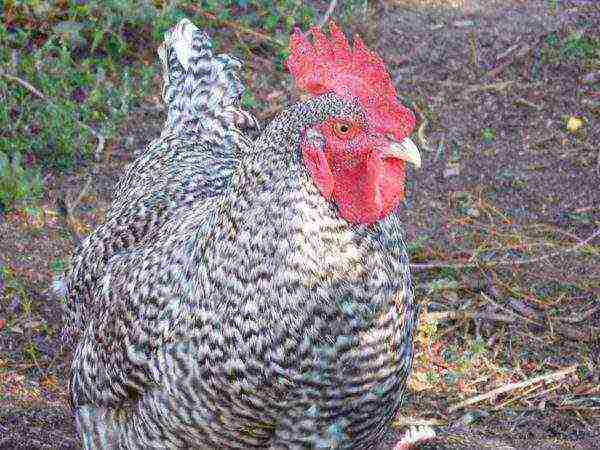
- Diet meatbecause it contains a lot of complete proteins and little fat. Possesses excellent taste: dense, but juicy, tender, tasty.
- Chickens are different high egg production... According to various sources, they start laying eggs at 4-6 months and give 200-300 eggs per year. Egg weight - 65-90 grams. The shell is creamy, brown.
Disadvantages of chicken breeding
master gray fertile layers and good brood hens. But often chickens incubated in a private courtyard turn out to be the descendants of chickens used in the process of hybrid breeding.
From chicken to layer
 Chicks of the cross are hardy, resistant to weather fluctuations.
Chicks of the cross are hardy, resistant to weather fluctuations.
- Subject to the established rules for keeping poultry, a balanced diet and a sufficient amount of feed no more than 2% of chickens die.
- They grow intensively, gain weight quickly. If a month-old chicken weighs 1 kilogram, then at 3 months - more than 2.5 kilograms... The increase in carcass weight occurs without any chemical enhancers.
Breed care cross master gray
When grown, domestic chickens, hybrids and crosses will be healthy if certain conditions of their keeping are observed.
- Cage, chicken coop should be warm, clean, dry, bright in summer and winter. The height of the chicken coop is not less than 1.8 meters. There are perches in the chicken coop.

- Need constant ventilation of the poultry house through a window that overlooks (preferably) the south side.
- Drafts contraindicated.
- For every 10 m2 premises - no more 20 crosses.
- In the winter season, it is recommended cover the floor dry grass, sawdust, chopped straw. Chickens love to nibble dry blades of grass, especially nettles. It is a source of vitamins.
- Layers must need nestsequipped in wooden boxes.
- The size of the nests depends on the size of the largest hen. Recommended sizes: Width - 35 cm, Length - 40 cm
- Nesting places located away from the space of active mass movement of chickens.
- The brooding hen is isolated. After the appearance chicks contain separately from the adult bird until the chickens grow up.
Disinfection as disease prevention
It is carried out in this way:
- Inventory is being processed 3-5% hot soda ash solution.
- Ceiling, floor, walls disinfect one of the chemical solutions:
- 3-5% creolin or xylonaft;
- 2% caustic soda;
- 3% formalin.
- It is important to whitewash 20% lime solution walls and ceiling. Maintain disinfection mode for 12 hours, ventilate thoroughly.
- In the poultry house or on the pasture place a container with sand and ash for "bathing" chickens. The procedure is necessary for the prevention and control of skin parasites.
Feed for chickens and adult poultry
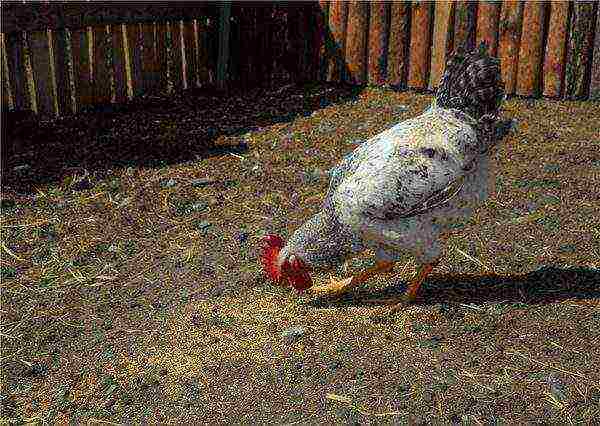 You need to feed the bird master grizz by age, fully. Then the chickens will be healthy, grow quickly and rush on time. For one adult chicken per day - about 120 g of feed, water - 250 ml.
You need to feed the bird master grizz by age, fully. Then the chickens will be healthy, grow quickly and rush on time. For one adult chicken per day - about 120 g of feed, water - 250 ml.
Feeding conditions for crosses
- Classical feed product is a ready-made compound feed, which includes all the necessary components of good nutrition.
- Healthy include in the diet wheat, corn, cake, beets, carrots, grass, bone meal, fish.
- For the fortress egg shells, mineral additives must be added: chalk, crushed egg shells, crushed limestone and shell rock. Provide constant access to them.
Natural additives stimulate the work of the gastrointestinal tract, increase egg production, improve the taste and appearance of products.
The use of top dressing reduces the amount of the main food.Keeping chickens becomes less costly.
Raising Chicks: Feeding Tips
- Just hatched chicks the owners of private farmsteads are first fed with finely chopped boiled eggs and green onions.
- Then add millet, fresh cottage cheese, crumbly buckwheat porridge, wet mash of crushed grain are introduced.
- Gradually give out cereals larger, they switch to the menu of an adult bird.
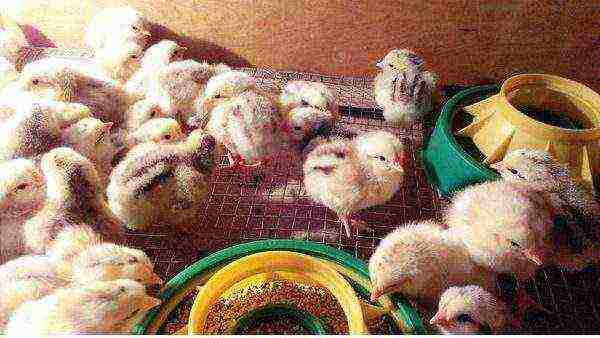 Young animals are fed with the following compound feed:
Young animals are fed with the following compound feed:
- From birth to two months - PC -2.
- From the eighth to the twentieth week - PC -4.
Important! You need to feed chickens of this breed at least twice a day, young animals more often. At night, they do not give wet food, but grain.
There must be clean drinking water.
Diseases of chickens, treatment
Viruses, microbes, parasites cause infectious and non-infectious, but contagious diseases of chickens. Poultry farmers should be aware of the common symptoms of diseases.
If the bird is lethargic, bald, vilified, or generally behaves strangely, measures must be taken. Carry out an external examination of the carcass, scallop, beard, feathers, legs. Parasites can be the cause of the disease.
Red chicken mite
It is a blood-sucking parasite that digs into the skin of a bird.
Signs of a tick:
- Chickens eat more, than usual.
- Falls egg production.
- Slows down growth chicks.
- Pale earrings and combs.
The parasite is a carrier of infectious diseases.
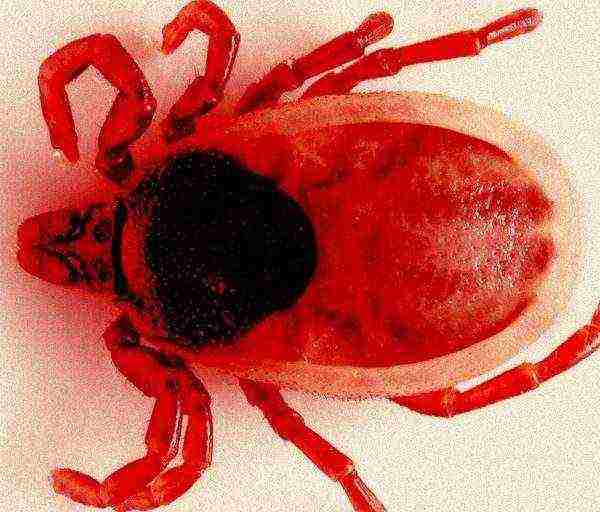 Tick eradication measures:
Tick eradication measures:
- solid disinfection premises, nests, containers, etc.,
- replacement litter,
- leather processing birds with oil.
Seek medical attention from your veterinarian.
Feather Chicken Mites
They settle on the feather shaft and in the hole. They feed on blood. The feather is destroyed, the bird becomes naked.
According to some reports, there is no positive result in the fight against feather mites.
Acariform parasites
Knemidocoptosis, or calcareous leg, is caused by ticks that settle on the legs of a bird, often a male.
Modifications of the legs:
- stratum corneum thickens,
- appears on the phalanges gray bloom,
- there is an intensive deformity of the legs.
Treatment: treat with birch tar, repeat after 6 days. Acaricidal medicines are also suitable.
Analogs of meat and egg crosses
Pharma color
- plumage - colored,
- egg - cream,
- chicken weight - 3.5-4.5 kg,
- egg production-250 pieces per year,
- weight eggs-60 g.
Tetra-N
- plumage - brown,
- egg - raspberry,
- bird weight - 2.8-4.5 kg,
- egg production-250 pieces per year,
- weight eggs-62 g.
Redbrough (Redbro)

- at redbrough legs longer than the master grizzly,
- egg production - up to 300 eggs per year,
- egg weight - 65 - 90 grams,
- weight of roosters in six months - up to 7 kg,
- egg-laying - at 4 months.
Reviews from forums and videos about the breed
Master Gray - my favorite chickens! They look beautiful, gain weight well, they also have very good egg production (up to 300 pcs / year), are unpretentious, frost-resistant. Meat of great taste, bred by French gourmets.
They are distinguished by the amount of meat and high egg production. Up to 300 eggs per year, when ordinary eggs yield 180 - 200 eggs. Yes, and they do not ask for a large area of kurchat, therefore it is a pleasure to grow them. Only positive reviews!
poultry forum
The master gray chicken will delight the most discerning poultry farmers with excellent characteristics, housing conditions, and aesthetic appearance.
